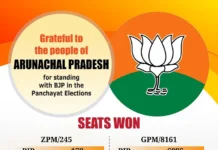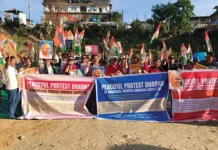[ Ajay Tripathy ]
In an earlier article published in this daily, I highlighted the credibility of recent malaria data in Arunachal Pradesh as irrespective of a good number of Blood Smear Examinations (BSE) state’s morbidity and mortality numbers are difficult to believe. It is not just the case of current year’s malaria data but it might be happening since years so let us examine the issue on the basis of data available through state government’s Civil Registration System (CRS) which the department of economics & statistics publishes.
While cooking rice in traditional way we usually select one grain from the large bowl to know whether entire rice is cooked properly. Likewise, we now take the annual report on registration of births & deaths for the year 2018 published by the government of Arunachal Pradesh on 30 December, 2019 that was the 35th issue of its kind.
In the year 2018, government of Arunachal Pradesh reported 1,45,353 BSE out of which 625 malaria-positive cases were detected. However, as per Arunachal’s health department no one died of malaria during 2018, it means all the 625 confirmed cases were treated and cured. Even if 625 cases from 1.45 Lakh BSE look fishy but let us not debate about it right now.
The question is to find out an evidence-based answer whether anyone died due to malaria during 2018 in Arunachal Pradesh? Let us find the answer from economics & statistics department’s CRS report for 2018.
As per the 2018 annual report on registration of births & deaths, 3,860 deaths were registered in Arunachal Pradesh. However, among those deaths no cause was stated for 2,426 deaths.
In fact, as per that CRS report 110 people died due to malaria in Arunachal Pradesh during the year 2018. Coming to the 2,426 cause not stated deaths let us not speculate too much, although many unconfirmed malaria deaths would also be there.
Now, let us break down these 110 confirmed malaria deaths. As per the CRS report, 55 malaria deaths took place in rural areas. So, an equal number of malaria deaths were also registered in urban areas of Arunachal.
Among all malaria deaths; 83 were male and 27-female. Maximum number of 23 malaria deaths was registered in the age group of 45-54. Nineteen malaria deaths were from 70 & above years. Six malaria deaths were from 65-69 age group.
Seven of 110 deaths were from below 15-year group; whereas five malaria deaths took place among the 15-24 years. Seventeen people died due to malaria in 25-34 age group however, sixteen malaria deaths were among the 35-44 age group.
Coming to the rural area; five malaria deaths were registered in below 15 age group. And, in the same age group for urban Arunachal only two malaria deaths took place. For more details kindly refer to death-table number 9, 10, 16, 17 and 18 between page 63-110 of that CRS report.
So, why Arunachal’s health department reported no malaria death when 110 people died due to malaria in 2018? It is noteworthy that Arunachal already reported zero malaria death in year 2000, 2002, 2003, 2004, 2005, 2017, 2018, 2019, 2020, 2021 and 2022. This year too no malaria death was reported in Arunachal until 25 October as per the data published by National Vector Borne Disease Control Program.
Now the government of Arunachal Pradesh may go through all its CRS reports to rectify the malaria death data. It is needless to mention that both the departments’ malaria death data must match meticulously for all the years. Eventually, hiding of malaria deaths in Arunachal also leads to the generation of contradictory reports at national level.
If you check the national health profiles, published by health ministry, zero malaria death is reported for 2018 as it uses health department’s data from state(s). However, the report on medical certification of cause of death (MCCD) 2018 published by the home ministry of India shows two extra malaria deaths for Arunachal which probably copied & pasted state CRS report’s clerical error from its death table number-9 where 23 deaths were showed as 25, aged 45-54, thus 110 malaria deaths became 112 in home ministry data that the health systems reported zero.
(Author is a public health professional who worked at CMC-Vellore, ICMR-RMRC, UNDP. He can be contacted at ajaytripathy@hotmail.com)





